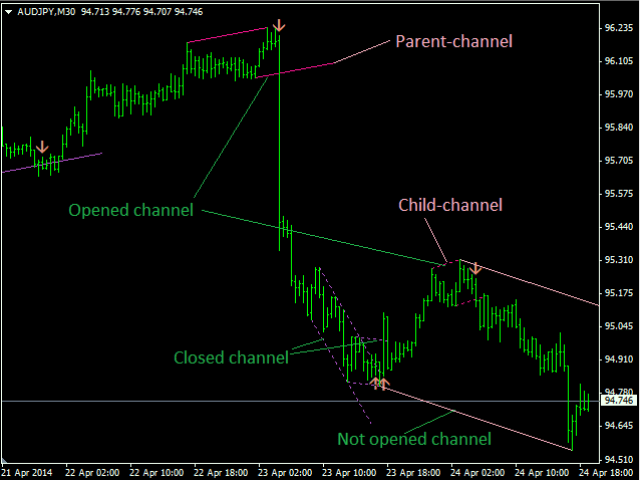The indicator allows you to find the start points of a correction or reversal. It provides good entry points to the market. It is easy to use and has rich customization options for demanding traders. It will help you find short-term and long-term trends.
The basis for constructing reversal channels or divergence channels is the search for divergence by the RSI indicator. The calculation of the RSI values is performed with different periods, depending on the properties of the channels themselves. The calculations of this indicator use the assumptions of the Elliott wave theory. The indicator is set to search for divergence channels, the vertices of which are the 3 and 5 Elliott waves. Also, these channels are often formed on the last wave of correction.
The channel is built on two vertices where there is a divergence, and is built in such a way that all the bars between these vertices are inside the channel.
A channel can have three consecutive statuses: not open, open, and closed.
- Not open – the state of the channel in which the channel boundary was not broken.
- Open – the state of the channel, if it is broken. The opening of the channel is the main signal of the indicator to enter the market.
- A channel breakout is the opening of a new bar outside its lines.
- Closed-the channel was closed based on the completed closing conditions. Closing a channel can be a signal to close an order opened on this channel.
[spoiler title=”Read More…”]
The channel can be trending or simple.
- A trend channel is a channel that has passed a certain test of the background of its formation. Often, trend channels are formed at the tops of the 3 and 5 waves of the momentum, and the opening of this channel indicates the beginning of a correction to the momentum or the beginning of the formation of a new trend.
- A simple channel is a channel that has not passed the trend channel check. Sometimes a simple channel can be formed at the tops of correction waves, and the opening of such a channel is a powerful signal for the development of a new wave of momentum.
Channels are compared by their size. A channel can be either a master or a slave.
- A subordinate (child) channel is a channel that is a certain number of times smaller than the main channel in terms of its size (length and/or height). The subordinate channel determines the short-term trend. The subordinate channel is represented by a dashed line.
- Main (parent) channel-determines a longer-term trend. The main channel may not have any subordinate channels.
Any new open channel that is larger or comparable in size to the previous channel closes the previous one.
- The channel length is the number of bars between the channel vertices.
- A wave in the direction of channel development (WCh) is a movement of the price starting from the minimum/maximum price inside the channel to its right top. It is unidirectional with the channel.
- A channel breakout wave (WBr) is a price movement from its right top to the breakout. It is directed against the direction of the channel.
The channel can be closed in the following cases, if the corresponding option is set in the indicator parameters:
- If a larger or comparable channel was opened.
- If the closing conditions for the breakdown of volatility are met. If the Closure type channel by type amplitude parameter is set to CLOSE_CH_V_TYPE, then the channel will be closed when the price for the time equal to the channel length goes back and forth by more than the channel width or the height of the fifth wave (depending on the parameter).
- If the price has fallen/risen higher than the lowest / highest price of the channel.
- If the channel’s lifetime is over.
All options, except for the reverse channel breakout, can be enabled or disabled in the “Conditions to close channels” parameter group.
- Volatility of channel-this value characterizes the value of the price spread within the channel boundaries (the channel boundaries along the length are its vertices). Changes from 0 to 1.
- Spike of channel-characterizes the measure of the spread of the tops (high/low) of the bars to the lower or upper border of the channel. Is equal to the ratio of the number of vertices above the line dividing the channel in the middle to the number of vertices below this line.
- Spike of breakthrough-the calculation is similar to the spike channel, but the interval of bars for the calculation is from the lower / upper price of the channel to the breakout for the up/down directional channel.
- Force of breakthrough-compares the speed of the breakout relative to the speed of the wave in the direction of the channel development.
- Relative wave length of breakthrough (relative channel breakout wavelength) – the ratio of the breakout wavelength to the wavelength in the direction of the channel development. If the indicator is greater than 1, then the breakout wave is longer.
[/spoiler]





